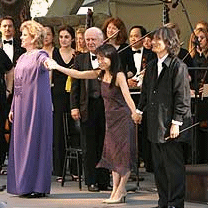

b. 1961, Seoul, Korea -

Award winning composer Unsuk Chin is known for the diversity of her music. Her works include music for voice, tape, electronics, solo piano, ensembles of every size as well as orchestra.
Chin began her musical career as a child in her native Seoul, Korea. She attended the Seoul National University, there she studied composition under Sukhi Kang. She appeared as pianist at the Pan Music Festivals and in 1984 her work “Gestalten” (“Figures”) was selected for the ISCM World Music Days in Canada and for UNESCO's Rostrum for Composers. In 1985 she moved to Hamburg, Germany, and studied composition with 1986 Grawemeyer winner György Ligeti, thankls to a DAAD grant, until 1988 (Ligati has just recently passed away, June 12, 2006). She has lived in Berlin since, and in 2001/02, served as composer-in-residence with the Deutsches Symphonie Orchester, which commissioned a new Violin Concerto that premiered in January 2002 by violinist Viviane Hagner and the Deutsches Symphonie Orchester conducted by Kent Nagano, the 25-minute concerto has been described as “a synthesis of glittering orchestration, rarefied sonorities, volatility of expression, musical puzzles and unexpected turns.” Written in four movements, the work is influenced by both Western and Eastern traditions and blends aspects of older and more contemporary classical forms. An extremely demanding violin solo complements rather than competes with the orchestral material. This work won Chin the 2004 University of Louisville Grawemeyer Award for Music Composition Chin began receiving international acclaim in 1991 with the premiere of “Akrostichon-Wortspiel” (Acrostic Wordplay) for soprano and ensemble, a work that has been widely performed in 15 countries. Her music is now conducted by leading figures including Kent Nagano, George Benjamin and Sir Simon Rattle. Unsuk Chin’s commissions have included those from such prestigious ensembles and institutions as Ensemble InterContemporain, the Kronos Quartet, bbc (for Hilliard Ensemble) and the London Philharmonic. "My music is a reflection of my dreams. I try to render into music the visions of immense light and of an incredible magnificence of colours that I see in all my dreams, a play of light and colours floating through the room and at the same time forming a fluid sound sculpture. Its beauty is very abstract and remote, but it is for these very qualities that it addresses the emotions and can communicate joy and warmth." — Unsuk Chin, 2003 Selected works: Die Troerinnen for three female voices, female choir and orchestra (1986), Gradus ad Infinitum for tape (1989), Akrostichon-Wortspiel, seven scenes from a fairy-tale for soprano and ensemble (1991, rev. 1993), El Aliento de la Sombra for tape (1992), santika Ekatala for orchestra (1993, rev. 1996), Allegro ma non troppo for tape or percussion and tape (1994–98), Fantaisie mécanique for five instruments (1994, rev. 1997), Piano Etudes (since 1995), ParaMetaString for string quartet and tape (1996), Piano Concerto (1996–97), Xi for ensemble and electronics (1998), Miroirs des temps for alto, two tenors, bass and orchestra (1999, rev. 2001), Kalá for soprano, bass, mixed choir and orchestra (2000), Spectres.speculaire for violin and live electronics (2000), Violin Concerto (2001), Double Concerto for piano, percussion and ensemble (2002), snagS & Snarls for voice and orchestra (2003–04). snagS & Snarls snagS & Snarls may not be easy for the average typist, but it made for a highly entertaining song cycle. These are scenes from Chin’s opera Alice in Wonderland, an opera commissioned by and given their first performance by the Los Angeles Opera Orchestra conducted by Kent Nagano, with Margaret Thompson as soloist (August 2004). Chin based the work on material from Lewis Carroll's Alice In Wonderland, the text was modified lightly for musical gain. The composer is co-writing the libretto, which is drawn from Lewis Carroll’s classic tale, with the award-winning playwright David Henry Hwang, author of M. Butterfly. snagS & Snarls reveals an ideal match between the wordplay in Lewis Carroll’s text and the musical games in Chin’s music, whether the pointillist teardropping syllables of "Who in the world am I", or the violent assault and cries of "Speak roughly to your little Boy". 
"Ms Chin gives us delicate whimsy, modal chanting, touches of metrical ambiguity, a little Sprechstimme, and fastidious raucousness…" New York Times "The Victorian poetry of the first song, Alice-Acrostic, was underscored by allusions to early music. The third song The Tale-Tail of the Mouse, in which Carroll’s poetry snakes down the page, was the most interesting, as if textural invention gave Chin permission to let voice and orchestra do some inventive slipping and sliding of their own." Los Angeles Times Photo: Unsuk Chin takes a bow at the Ojai Festival premiere of snagS & Snarls, with soprano Margaret Thompson and conductor Kent Nagano (Image: Robert Millard) Read more about Unsuk Chin in the Arts & Living section in the Seoul Times: Also a review of the premiere of her Violin Concerto in classictoday.com: |